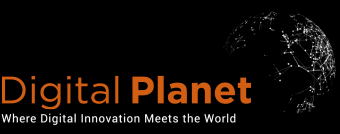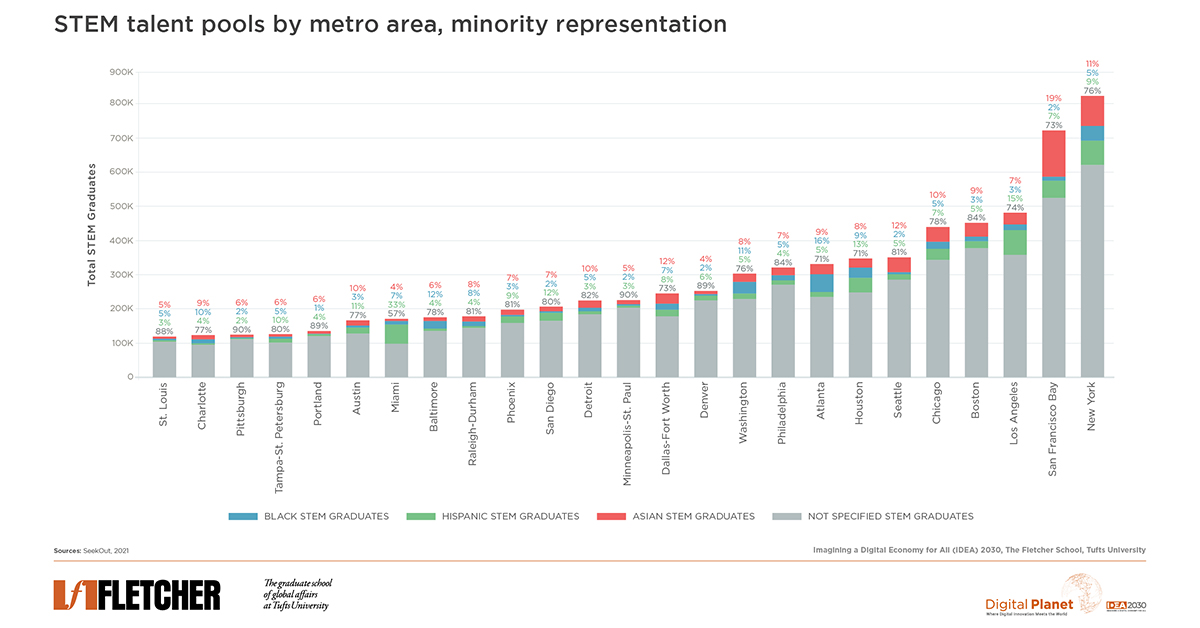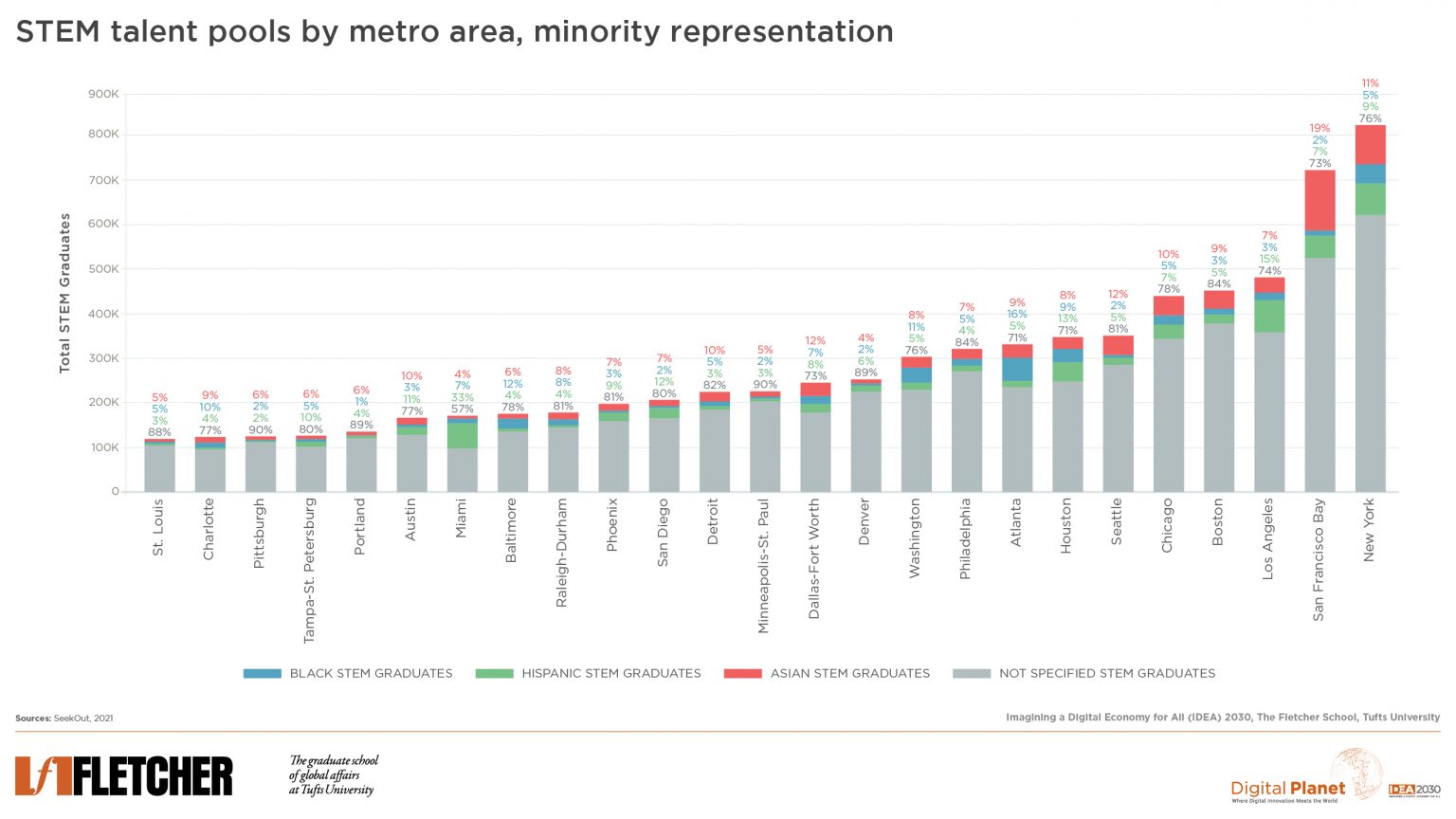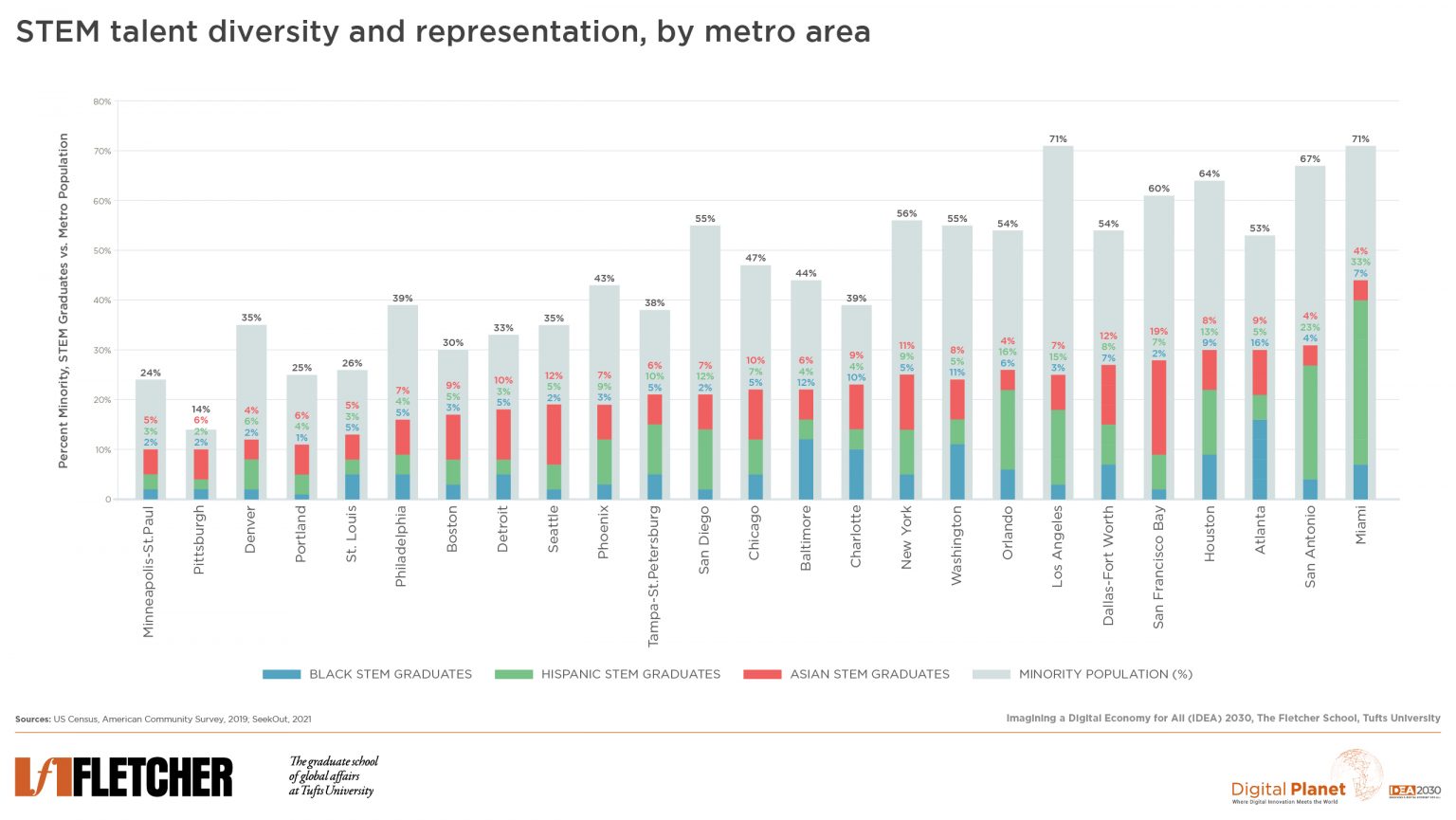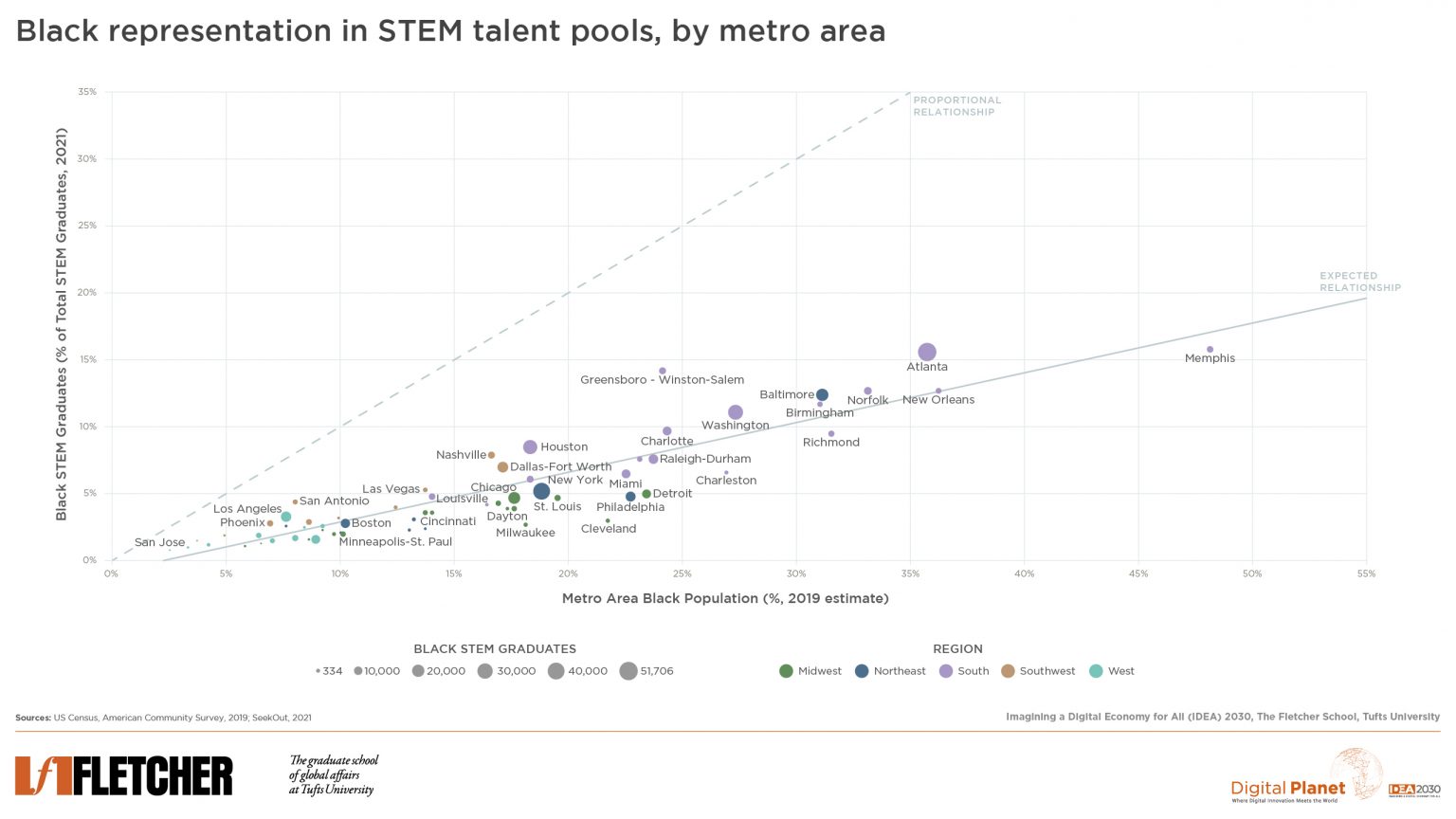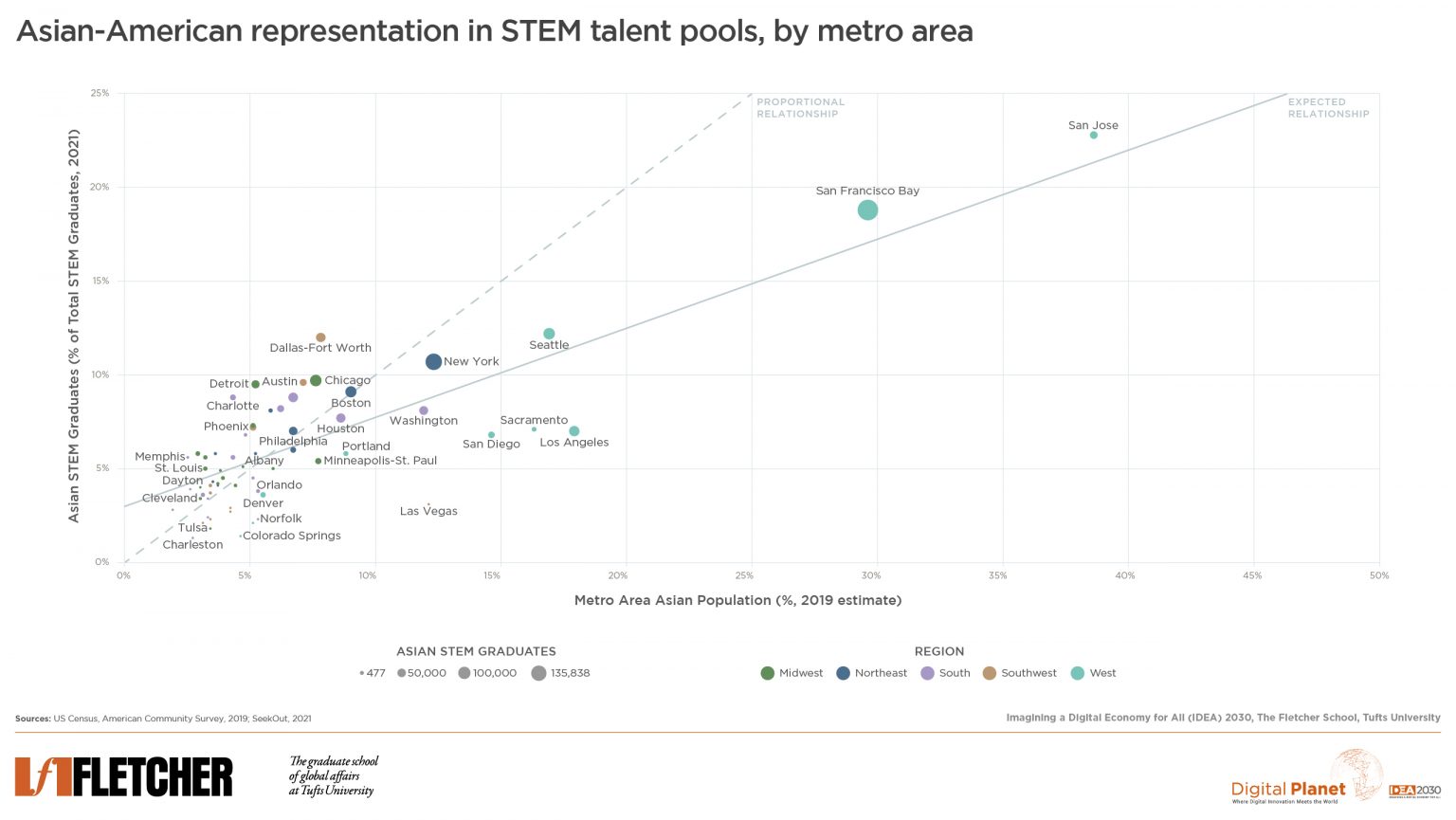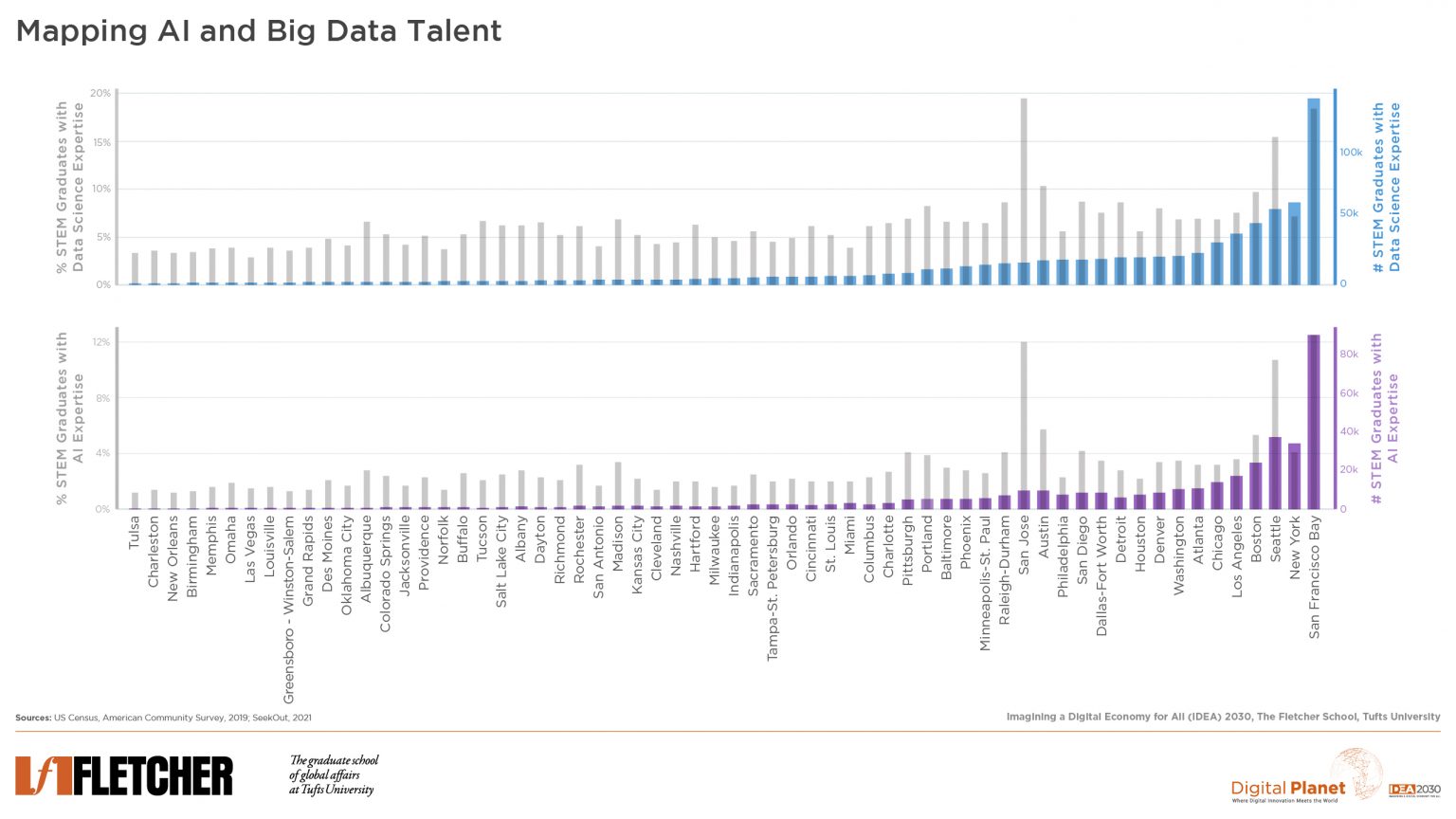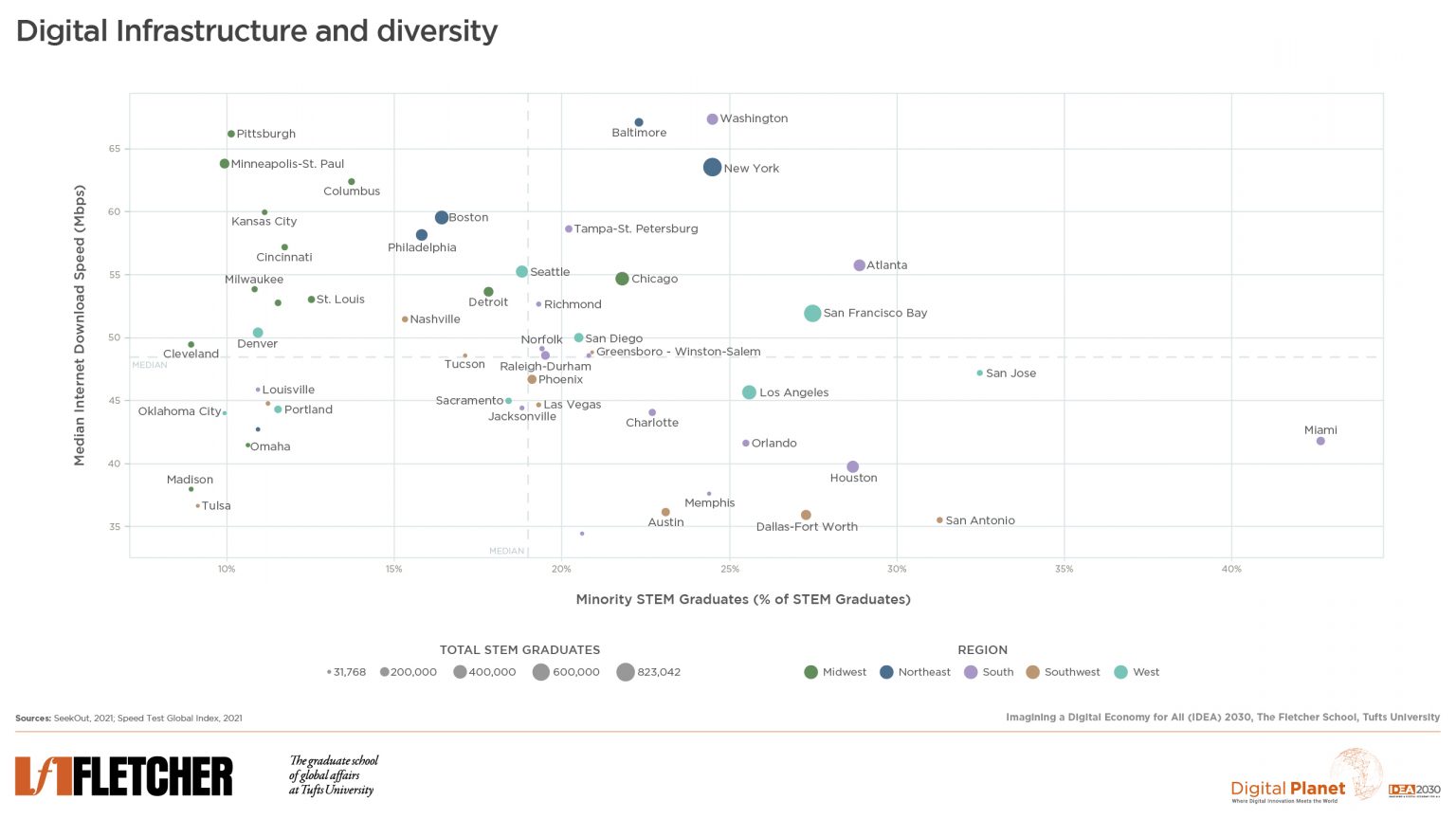Home > Off the Charts > The Shifting Geography of Talent
The Shifting Geography of Talent:
STEM Talent, Diversity, and Internet Readiness Across the US Metro Areas
Summary
The pandemic is changing the geography of American tech. As America’s tech sector embraces pandemic-induced momentum towards remote or hybrid work, it is also reevaluating the long-held belief in the necessity of a headquarters in the industry’s traditional epicenters. The potential for a redistribution of tech jobs to new corners of the country presents an opportunity for tech companies to prioritize diversity and inclusion. This analysis of the shape, size, and makeup of tech talent pools in 60 US metro areas finds that Black representation in tech pools lag overall metro representation by the greatest margins of any minority group. With a look to gender parity, our analysis confirms a major disparity in representation. However, we find the gap narrows when evaluating the disparity among STEM talent in medical-related fields. Finally, we identify key cities with first-class digital infrastructure and talent diversity.
Key Observations and Insights
The COVID-19 pandemic has sparked a transformation of the geography of the American tech industry.
The remote work revolution has granted newfound mobility to tech industry professionals, and many are grasping the opportunity to leave the traditional capitals of tech for greener—and cheaper—pastures.
A new survey reveals that nearly half of all tech workers have opted to move since the beginning of the pandemic, departing the pricey tech hubs of Seattle and San Francisco for more affordable alternatives such as Dallas, Houston, and Miami. Nearly a fifth of tech professionals surveyed are abandoning the nation’s crowded major metros altogether, in some cases lured away by generous relocation incentives offered up by savvy state and local governments.
Tech companies themselves have not been obtuse to the shifting landscape of tech talent. Many, including Silicon Valley giants Facebook and Twitter, have pledged to let their employees continue remote work indefinitely. Others, like Oracle and Hewlett-Packard, have gone further, announcing plans to relocate their headquarters from California tech hubs to up-and-coming tech towns such as Austin, Houston, and Miami.
As more firms reevaluate where they set up shop, it is critical they consider not only the size of talent pools in candidate cities, but the diversity of those pools. For an industry with a justifiably poor reputation for gender and racial diversity, a redistribution of jobs to new corners of the country represents a chance to start afresh and prioritize inclusion.
It is with this in mind that Digital Planet continues to explore the changing geography of tech talent in the United States. Employing SeekOut’s AI-powered tech talent database, this analysis examines the scale and makeup of STEM graduate talent pools in 60 US metro areas. Talent pools across the US are broken down by gender, race, experience, and field of expertise to provide a view of the shape and distribution of the country’s STEM workforce.
This analysis reveals which cities have succeeded in fostering the most diverse and representative tech talent ecosystems, and which have the most pressing need to improve the diversity of their candidate pools. Finally, we identify key cities with ideal talent-infrastructure conditions for different segments of the tech industry, helping to light the path ahead as tech firms enter a new era of diffuse talent.
Diversity: Black, Hispanic, and Asian Talent
– The New York, San Francisco Bay, Los Angeles, Boston, and Chicago metro areas make up the top 5 largest STEM talent pools by size
– Among the 25 largest STEM talent pools, Miami, San Antonio, Atlanta, Houston, and San Francisco Bay were the most diverse
– Representation of Black STEM talent as a percent of the total STEM talent pool was lower than that of Asians and Hispanics, and lagged overall metro representation rates by the greatest margins
– While Atlanta, Memphis, and Greensboro-Winston-Salem have the highest rates of Black talent within their overall STEM talent pools, Greensboro-Winston-Salem, Houston, and Nashville were the top performers for Black STEM diversity, measured by the ratio of Black representation in the STEM talent base to Black representation in the metro area overall
– The picture is a bit different for Hispanic talent. The rate of representation among STEM grads for Hispanics in most metro areas is significantly closer to the rate of overall metro representation than in the case of Black STEM grads. Among metro areas with more than 10% overall Hispanic representation, top performers include the three Florida metros of Miami, Orlando, and Tampa-St. Petersburg

– Only a handful of cities display above median representation rates in their STEM talent pools for both Black and Hispanic STEM grads. These dually diverse cities include New York, Chicago, Dallas, Houston, Miami, and Atlanta
– In many metro areas around the country, particularly those in the Midwestern, Southern, and Southwestern regions, Asians were represented in the STEM grad talent base at a greater rate than their representation in the overall metro
Gender Diversity
– The gender breakdown among STEM grads by metro area was relatively consistent, with most cities clustered around the median of 31% female representation
– The state of gender parity is better for STEM talent in the fields of healthcare, medicine, or biotech. While women are still under-represented, the disparity in gender representation is reduced from a 40% difference to just 12% in fields that have a bio-medical component
– While Boston, Charleston, and Nashville have the highest percentage of STEM talent that are also in the fields of healthcare, medicine, and biotech, New York, Boston, Philadelphia, and Chicago comprise the leading concentrations of talent in medicine-related STEM fields. All of these metro areas also are above the median in terms of gender parity
High Tech and Internet Readiness
– Talent pools for both AI and Big Data remain far more concentrated in the traditional epicenters of tech than the STEM graduate pool overall. That said, several middle-tier cities have respectably sized talent concentrations for AI and Big Data. Denver, San Diego, Dallas, Detroit, Austin, and Raleigh-Durham represent the key players in this middle tier
– The largest STEM talent hubs have faster internet speeds, but not the fastest. The middle-sized metros of Washington, DC, Baltimore, Pittsburgh, and Minneapolis deliver the highest download speeds
– Previous research on the geography of work across the US indicates many of these mid-tier cities offer workers more affordable living costs and employers superior “digital readiness”
– The diverse tech hubs of the South and Southwest must invest in their digital infrastructure to retain jobs and talent, while midsized and small Midwestern tech hubs could market their premium infrastructure to attract diverse, young STEM talent
Methodology
Data was collected using the SeekOut proprietary database. SeekOut, an AI-powered platform for recruiting, uses algorithms to “scrape” publicly available resumes from all over the web. Candidates are not necessarily looking for work, and are most often currently employed. For each metro area, data on the number of STEM grads was collected by filtering STEM graduates for the respective metro area. Data on gender, experience, field of expertise, and race was collected by applying next-order filters to metro-specific data. STEM graduates, according to SeekOut, include those people “with a degree in a science, technology, engineering, or math field.”
To estimate the number of STEM graduates working in the medical-related fields, an additional keyword requirement for the word “medical” was applied. As this filter returned anywhere from 12% to 25% of the overall STEM pool for each metro, this additional keyword requirement was assumed to be fairly inclusive of various professions. These candidates need not be scientists, technicians, or programmers, and can be any medical professional with a STEM degree. To estimate the number of STEM graduates with expertise in AI or Big Data, inclusive “power filters” for candidates with machine learning and deep learning or big data and data science were applied, respectively.
Reported racial representation ratios were calculated by dividing percent representation in the STEM talent pool by percent representation for the overall metro area.
Internet speed data comes from SpeedTest Global Index (Q1, 2021). Demographic data comes from the US Census American Community Survey (2019, 5-year estimates).
All data and sources are available for download here.
Digital Planet Analyst Griffin Brewer worked on this analysis under the guidance of Bhaskar Chakravorti and Christina Filipovic at Digital Planet, The Fletcher School, Tufts University.
This research is a part of the IDEA 2030 initiative, made possible by the generous support from the Mastercard Center for Inclusive Growth
